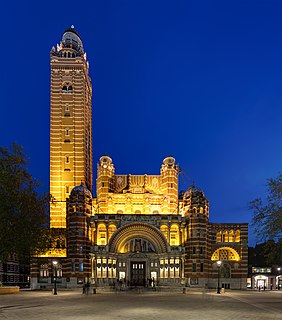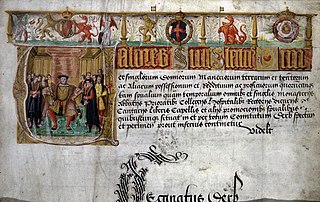External links
| This article about a British Christian monastery, abbey, priory or other religious house is a stub. You can help Wikipedia by expanding it. |
St Gregory's Priory at Canterbury was an English House of the Augustinian Canons Regular. Its foundation is attributed to Lanfranc, archbishop of Canterbury in the 11th century.
Subsequent to the Reformation Parliament and the Act of Supremacy, the priory was dissolved 1535 during the dissolution of monasteries of the English Reformation. Its last prior was John Symkyns, elected 1535.
| This article about a British Christian monastery, abbey, priory or other religious house is a stub. You can help Wikipedia by expanding it. |

The Archbishop of Canterbury is the senior bishop and principal leader of the Church of England, the symbolic head of the worldwide Anglican Communion and the diocesan bishop of the Diocese of Canterbury. The current archbishop is Justin Welby, who was enthroned at Canterbury Cathedral on 21 March 2013. Welby is the 105th in a line which goes back more than 1400 years to Augustine of Canterbury, the "Apostle to the English", sent from Rome in the year 597. Welby succeeded Rowan Williams.

The Benedictines, officially the Order of Saint Benedict, are a monastic religious order of the Catholic Church following the Rule of Saint Benedict. They are also sometimes called the Black Monks, in reference to the colour of their religious habits. They were founded by Saint Benedict of Nursia, a 6th-century monk who lay the foundations of Benedictine monasticism through the formulation of his Rule of Saint Benedict.

Reginald Pole was an English cardinal of the Catholic Church and Catholic archbishop of Canterbury, holding the office from 1556 to 1558, during the Counter-Reformation.

The Dean of Canterbury is the head of the Chapter of the Cathedral of Christ Church, Canterbury, England. The current office of dean originated after the English Reformation, although Deans had also existed before this time; its immediate precursor office was the prior of the cathedral-monastery. The current Dean is Robert Willis, who was appointed in 2001 and is the 39th Dean since the Reformation, though the position of Dean and Prior as the religious head of the community is almost identical so the line is unbroken back to the time of the foundation of the community by Saint Augustine in AD 597.

Lower Catesby is a hamlet in the civil parish of Catesby, Northamptonshire, about 4 miles (6.4 km) southwest of Daventry. Lower Catesby is beside the nascent River Leam, which rises about 1 mile (1.6 km) to the south in the parish of Hellidon. The Jurassic Way long-distance footpath passes through Lower Catesby. The population of the hamlet is included in the civil parish of Hellidon.
Folkestone Priory was a pre-Reformation Benedictine monastery at Folkestone in the English county of Kent. The priory church survives as the present parish church. It was the successor to Folkestone Abbey, an Anglo-Saxon nunnery on a different site.

The Catholic Church in England and Wales is part of the worldwide Catholic Church in full communion with the pope. It traces its history to the apostles through Catholic Christendom, the Western Latin Church, particularized and recorded in Roman Britain as far back as the 1st century. Later, in the 6th century, the church was judicially bonded to the Apostolic See of Rome, when Pope Gregory I through his Benedictine and Roman missionary, Augustine of Canterbury, established a direct link from the Kingdom of Kent to the Holy See in 597 AD. This ancient link to which Irenaeus says "every church" should "resort" on account of its "preeminent authority," has enriched the inter-church identity of the English Catholic Church, not only across Britain and continental Europe but also and especially globally within what is sometimes referred to as the "Catholic Communion of Churches".
John Stone was an English Augustinian friar who was executed, probably in December 1539; he was canonized in 1970 by Pope Paul VI. He was a doctor of theology from Canterbury.

Patrixbourne is a rural English village south-east of Canterbury in Kent, mostly taken up by agricultural hills. Along with almost contiguous Bekesbourne to the north it makes up the civil parish of Bekesbourne-with-Patrixbourne in the City of Canterbury district.

The Valor Ecclesiasticus was a survey of the finances of the church in England, Wales and English controlled parts of Ireland made in 1535 on the orders of Henry VIII.

Beauvale Priory was a Carthusian monastery in Beauvale, Nottinghamshire. It is a scheduled ancient monument.
Events from the 1530s in England.

Bentley Priory is an eighteenth to nineteenth century stately home and deer park in Stanmore on the northern edge of the Greater London area in the London Borough of Harrow.

Bradenstoke Priory was a medieval priory of Augustinian canons regular in the village of Bradenstoke, Wiltshire, England. In the 1930s the property was purchased by William Randolph Hearst and some of its structures were used by him for the renovation of St Donat's Castle, near Llantwit Major, Wales.
William Barlow was an English Augustinian prior turned bishop of four dioceses, a complex figure of the Protestant Reformation. Aspects of his life await scholarly clarification. Labelled by some a "weathercock reformer", he was in fact a staunch evangelical, an anti-Catholic and collaborator in the Dissolution of the Monasteries and dismantling of church estates; and largely consistent in his approach, apart from an early anti-Lutheran tract and a supposed recantation under Mary I. He was one of the four consecrators and the principal consecrator of Matthew Parker as archbishop of Canterbury in 1559.
William Kingsmill alias William Basyng was Prior of the Benedictine St. Swithun's, Winchester until the Dissolution of the Monastery in 1539. He was appointed as the first Dean of Winchester Cathedral at the foundation of the new chapter in 1541.
Saint Eanswith, also spelled Eanswythe or Eanswide, was an Anglo Saxon princess, who is said to have founded Folkestone Priory, one of the first Christian monastic communities for women in Britain. In 2020, osteoarchaeologists were given the opportunity to examine the remains of a skeleton long thought to be the remains of St. Eanswythe. They concluded that the bones belonged to a young female. Radiocarbon dating confirmed that the remains were from the mid-7th century, adding to the evidence that this may well be St. Eanswythe. The results of DNA and isotope analysis are pending. It can never be proven that the remains are St. Eanswythe but the evidence certainly indicates that this could be the case. If so, these are the earliest remains yet discovered of an English saint, and of a relative of the British monarch.

The Suppression of Religious Houses Act 1535, also referred to as the Act for the Dissolution of the Lesser Monasteries and as the Dissolution of Lesser Monasteries Act, was an Act of the Parliament of England enacted by the English Reformation Parliament in February 1535/36. It was the beginning of the legal process by which King Henry VIII set about the Dissolution of the Monasteries.
John Boys, of St. Gregory's, Canterbury, the Middle Temple, London and Betteshanger, Kent, was an English politician and 'Kent's leading lawyer'.